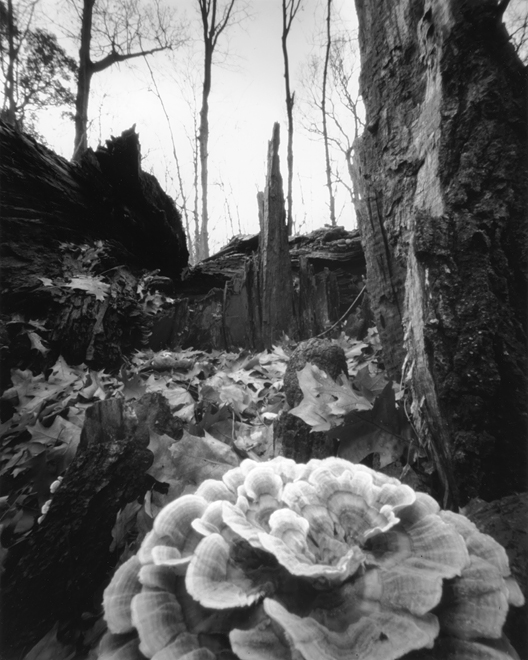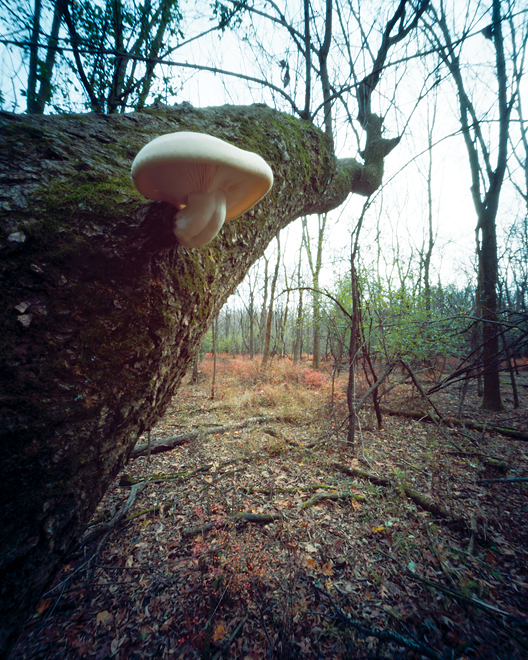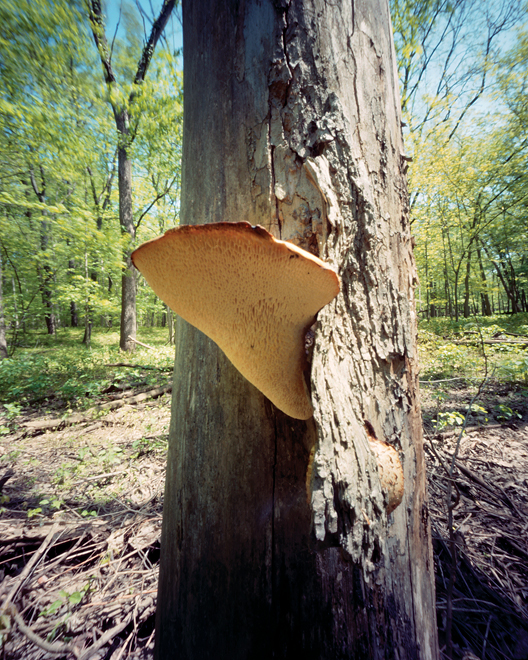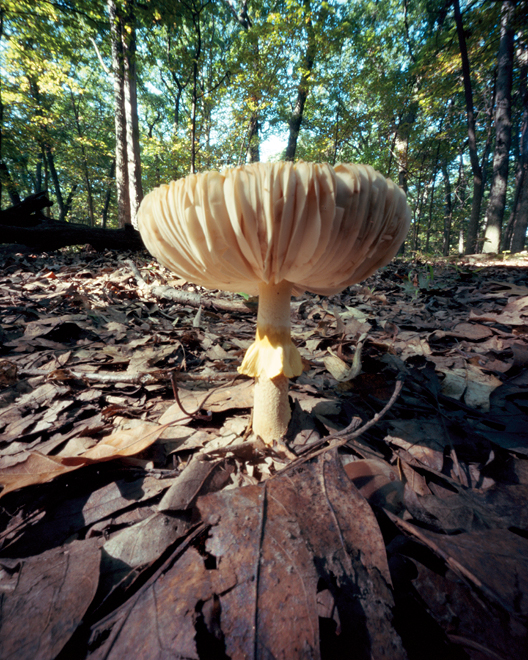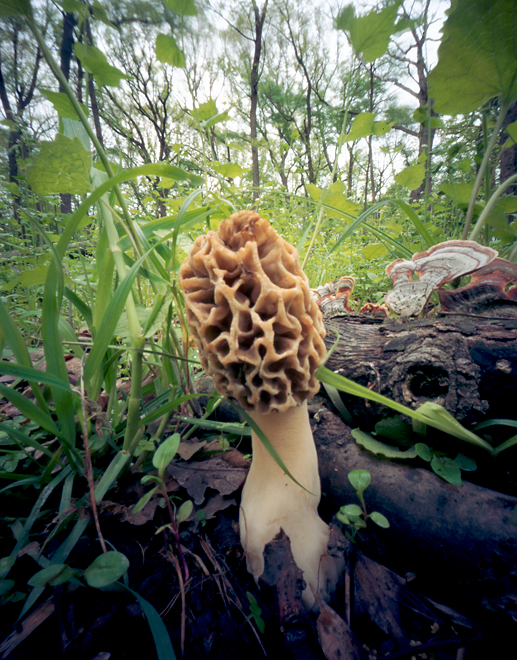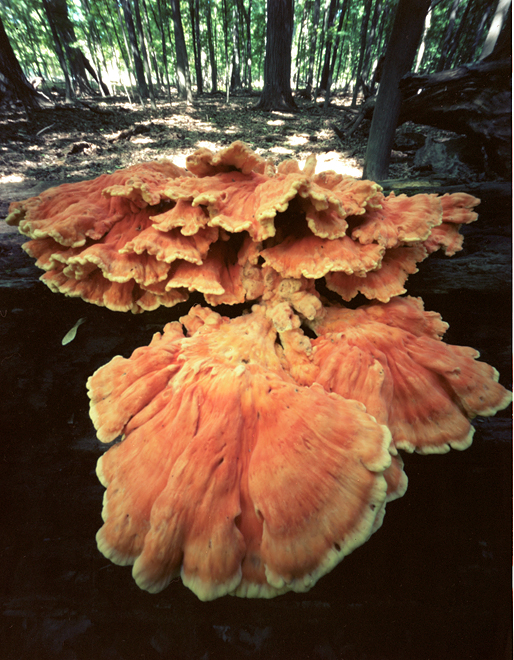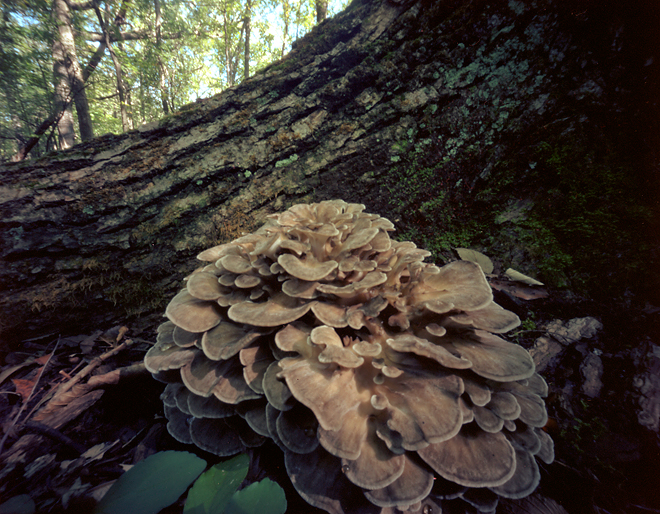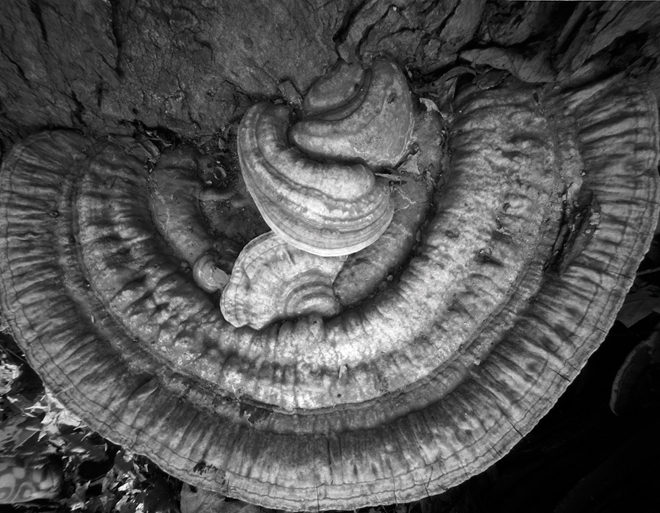I first became interested in pinhole photography when I took an alternative darkroom course at The School of the Art Institute of Chicago with Robert Clarke-Davis, a.k.a. Clarke. He taught us how to print cyanotypes, tintypes, and various other photographic processes common in the 19th Century. Among our assignments was to build a simple double-walled pinhole camera out of solid black foam-core board. We assembled our cameras at just the right size to accommodate standard 4″x5″ film holders, and then used an i545 Polaroid back to test for light leaks and other issues.
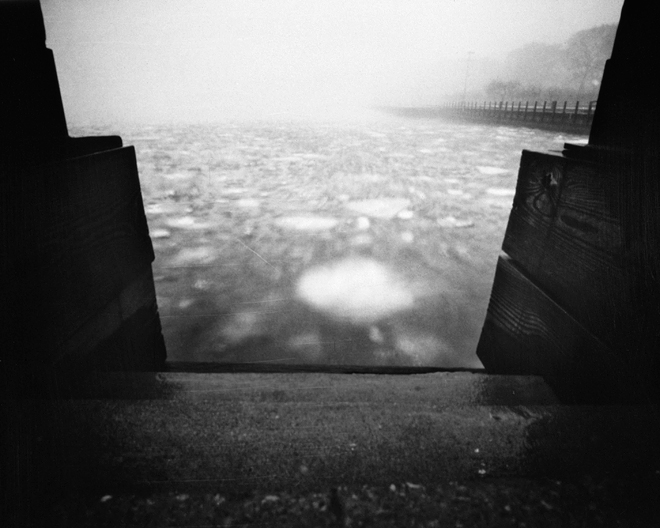
Whether digital or analog, 35mm or large format, all cameras have the same general anatomy: a hollow body with a circular opening on one end, and something that can record the upside-down image that forms on the other end. The hollow body can be any object: a boot, a bag of chips, a loaf of bread. (For the record… I’ve seen all of these firsthand.)
In a pinhole camera the circular opening—i.e. aperture—is just a simple hole proportional to the size of the camera body; there is no lens inserted into it. A living-room-sized camera would have a dime-sized hole; a shoebox camera would have a tiny pinhole. Once one has a hollow object with an aperture, all that is needed is photo-sensitive paper or film to record an image.
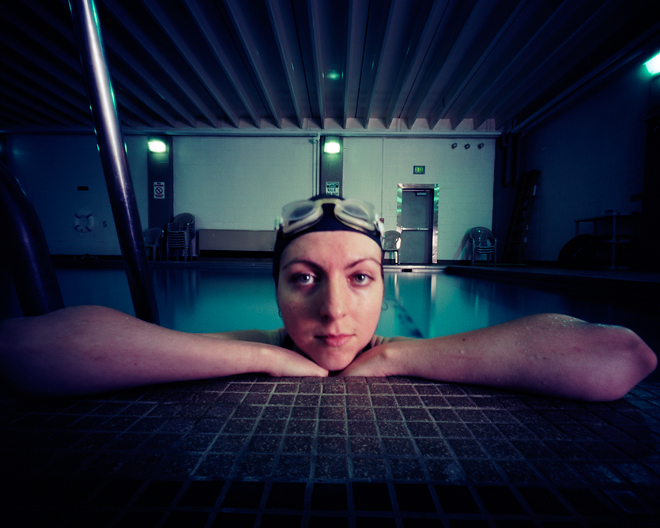
Pinhole photography became so central in my life that it turned into a graduate thesis. I shot hundreds of photographs on 4×5 color film with my handmade camera, and continued working with it regularly for several years after graduate school. I discovered both new subject matter and new ways to interact with the instrument. Despite the undeniable novelty of the camera, other things had me captivated mostly with regard to its rawness. Without a shutter, a built-in light meter, or a viewfinder, the pinhole camera requires a mindful use of one’s body and intuition. The phenomenon of taking a picture becomes a meditative process, a performance of sorts—so labor-intensive and enchanting that it takes on an importance greater than the image itself. The image becomes an excuse to engage with the camera and truly observe one’s environment. And the outcome is far from perfect: the resulting image has all of the flaws that we’ve spent centuries getting rid of with fancy lenses: distortion, skewed perspective, strange color translation, blur.
All of these make for an aesthetic of imperfection and decay, a wabi-sabi kind of beauty. With my love of this instrument and process, it’s no surprise that I later also became interested in mushrooms with all their fascinatingly similar evocations.
A photography-inclined friend of mine and I began going to the Indiana Dunes to shoot together. I was interested in the way the sand would swallow objects and randomly spit them out on any given day. Rusty machine parts, animal bones, feathers, twigs… I was using the camera to photograph decay, time passing, and transformation.
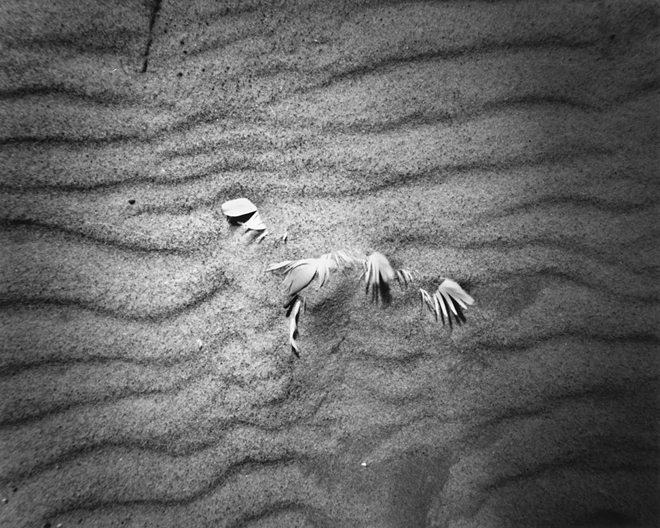
One day in Chicago, we found ourselves without enough time to drive to the dunes, so we opted for a suburban forest preserve instead. We didn’t have a specific goal in mind; the idea was to photograph leaves and branches—or anything that drew our attention. It was the day following a huge rain in November; the woods were damp, misty. Without any knowledge or understanding of mushrooms, we found ourselves surrounded by so many different species in their various manifestations and habitats that the event seemed supernatural. Every turkey tail, oyster mushroom, dryad saddle, every mysterious cluster—all of it was infinitely fascinating. Since then, I’ve become much more spoiled and selective, dismissing the common species and getting excited about the things I see less often. But I still remember the feeling of curiosity and fascination from that cold November day.
In hindsight, it makes perfect sense that the mushrooms immediately drew my attention. Mushrooms and my photos of them alluded to the same passing of time, decay, and transformation that I observed in the sand dunes. Mushrooms required concentration. They were going to disappear or change the following day, just like the objects in the sand. Soon, I had enough photographs for an exhibition, which led to some online searches and the discovery of the Illinois Mycological Association. Chasing fungi became a part of my life.
I quickly discovered that my usual pinhole camera could tackle most—but not all—mushrooms. There is a myth that pinhole cameras have infinite depth of field. I discovered that it actually begins somewhere around a couple of inches away from the camera and extends to infinity, which for most intents and purposes is indeed infinite. This was not the case for mushrooms that needed to be placed close to the aperture. Due to the extremely short focal length, small mushrooms looked even smaller unless I placed them within millimeters, not inches, of the camera. But due to the depth of field problem, this created an excessively blurry image.

All of these issues kept arising. I would find a beautiful mushroom and then realize that it’s one of those that cannot be adequately photographed with my camera. After a few incidents, the thought to design a new camera crossed my mind. Given that it was just a cardboard box with a hole punched on one side, it would have been easy enough to make a new one. My attention turned away from the photographs and toward the camera design: could I design a camera specifically for photographing mushrooms?
I was teaching view camera classes at the time (the kind with a large bellows and a “cloak” covering the photographer), and from discussions and experiences with students, the possibilities for a pinhole camera redesign based on view camera principles seemed quite feasible, and vividly so.
There are several things one can do with a view camera that cannot be done with the more common DSLR. In a view camera, the front standard (plate that holds the lens) and rear standard (plate that holds the digital sensor) can be moved and rotated in various directions independently of each other. The bellows between them acts like a dark flexible tube and prevents light from getting in regardless of the configuration in which one chooses to place the front and rear standards. Armed with the knowledge of what these camera movements can do and how focal length works, I decided to make some specific changes.
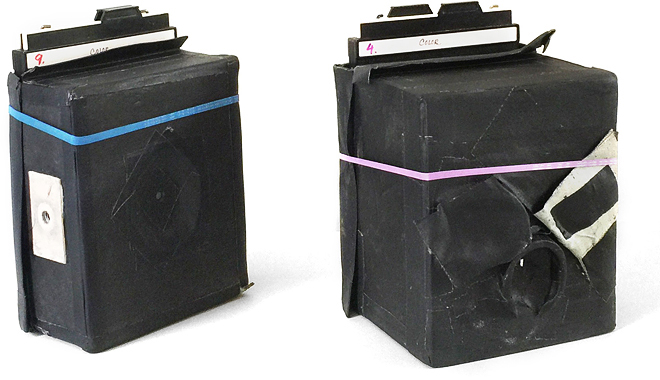
First, I dropped the pinhole closer to the bottom edge of the camera. In view camera photography, this is called a “front standard fall.” This movement lowers the location of the horizon line in the projected image, thus showing more ground and less sky (since the image is upside down). Luckily, this movement also places the pinhole at the height of a small mushroom. I soon realized that I needed two pinholes, one for horizontal and one for vertical shooting.
The most difficult part was the focal length and subsequently the pinhole diameter. To understand focal length, one just needs to look through a tube: the shorter the tube, the wider the angle of view and the more stuff one can see; the longer the tube, the narrower the view, showing only a small portion of the scene. A zoom lens has a variable focal length, but my pinhole camera’s focal length was going to be fixed at the length of the box itself.
So what would be an ideal focal length for mushrooms? According to my notes, I attempted 9 inches. This created too extreme of a close-up. I shortened it back to 5″ and ultimately down to 4″, which was still significantly longer than my wide-angle camera with a focal length somewhere around 2″. To run these experiments, I set up a still life with clothespins as stand-ins for mushrooms, and a ruler extended outward from the camera. This helped me see both the framing and depth of field created by the new design.
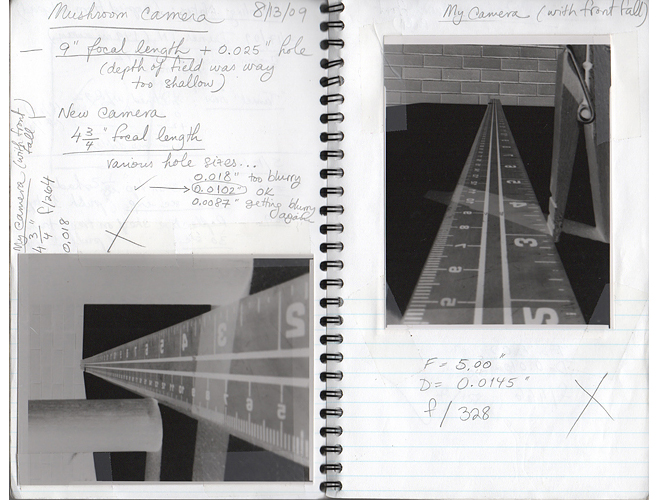
As a rule, pinhole photographs are always slightly blurry even when the optimal hole diameter is used. Generally, the smaller the hole, the sharper the image. However, as the pinhole gets smaller and smaller, eventually light diffraction kicks in, causing the image to get blurry again. So one needs to find the sweet spot—the optimal diameter of the hole based on a given focal length. Charts are available both online and in photography books to help determine the optimal pinhole size.
To create the hole, I would normally use a tiny drill bit purchased from a jewelry supplier with a thin sheet of aluminum from a disposable baking pan. This time however, I decided to purchase an assortment of tiny laser-drilled pinholes. After using the diameter recommended by online charts, I noticed that the images produced by my mushroom camera were significantly blurrier than the ones from my original wide-angle camera. So I needed to run my own tests: I attached a laser drilled hole to the new mushroom camera, ran outside, set up the ruler and clothespins, shot a photo on some photographic paper (ISO 4), and then ran back into the darkroom to develop and check for sharpness.
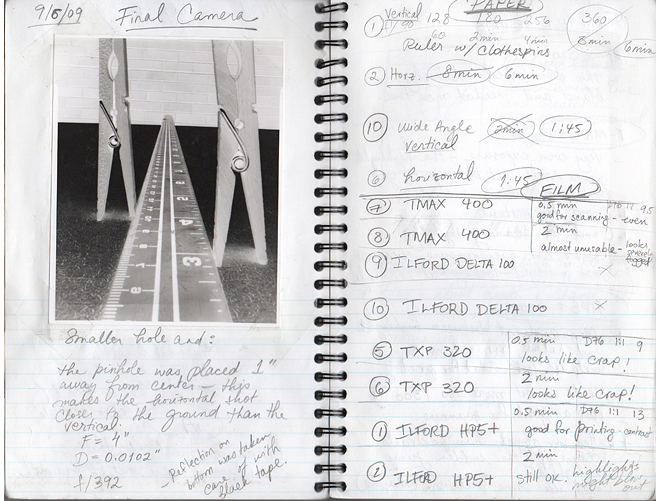
I used smaller and smaller hole diameters and compared images against each other. According to my notes, I was ultimately satisfied with a diameter of 0.0102″. This was much smaller than the charts recommended, but the images appeared sharper. A smaller hole meant less light in the camera, which in turn lengthened exposure times; but mushrooms don’t move around, so that was fine. The effective aperture on my new camera was f/392.
I thought I was done. The mushroom camera was ready for its first adventure. But after using a few sheets of film I noticed a recurring problem: a dark stripe at the bottom of the image. I went back to consult my notebook, and sure enough the tests had the same stripe at the bottom—I just hadn’t noticed it before. Was it due to a light leak, a lens flare, fogging of some sort?
Upon some pondering and by examining its location, I realized that the stripe was a shadow cast from the edge of the plastic film holder. The stripe must have been caused by a direct reflection of the sun’s image on the floor of the camera; the entire photograph was slightly fogged with the exception of the stripe. So it was a lens flare of sorts. Well, a hole flare. And there was only one solution for this problem: a hole hood. I made little visors out of black cardboard for each of the two holes. This took care of the problem, and the dark stripe was gone.
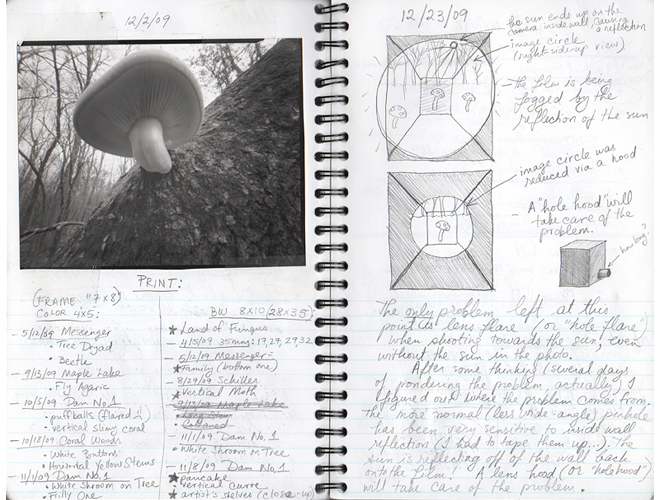
While I was still working with pinhole photography on a regular basis, I rarely used the new mushroom camera; the exposure times with my wide-angle camera were so much shorter—and most mushrooms were either large enough or positioned conveniently enough not to require it. In the end, I realized that the work of art resides in the camera itself and the process of creating it, much more than in the photos it produced. This was one of a string of pinhole camera developments that were more concerned with research and/or performance than the image-making.
Text originally published in Mushroom: The Journal of Wild Mushrooming in 2017.
